An Interview with Ramy Daoud, Pro MMA Fighter
by Adrienne Harvey PCC-TL, RKC-II, CK-FMS, Primal Move Nat'l Instructor
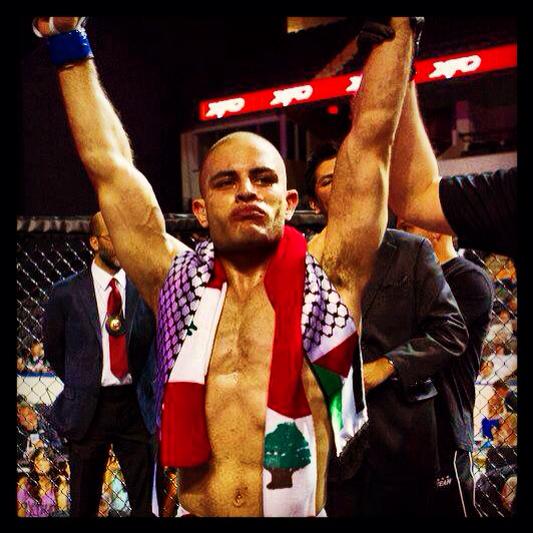
Dragon Door: How long have you been involved with MMA?
Ramy Daoud: I've been doing MMA since I was 17—so around 9 years. But, I've been practicing martial arts since I was about 5 years old, which gives me 21 years experience!
Dragon Door: In the
video from the Seattle RKC Workshop you attended, you said something very interesting—"This is the first time I’ve used kettlebells correctly." Can you elaborate on that?
Ramy Daoud: Yes, it definitely was the first time I'd used a kettlebell correctly! Even though I’ve trained with many different strength and conditioning coaches in my career—and they’ve all used kettlebells in our circuit training—we never really learned the technical details that really make the exercises work. I’m small but very strong for my size, so I was able to kind of get away with doing the exercises incorrectly and just use my athleticism and strength to carry me through the circuit. Many times, in circuit training for MMA, as long as you are doing the work, there isn’t much focus on technique. The
RKC was a different world for me since it was all about technique.
The instructors had to teach me how to do the basic exercises that I had been doing incorrectly. It’s a lot like martial arts, if a student comes to my school from a different gym and has been training incorrectly for years, it’s harder for me to teach them because we have to break bad habits first. I felt like that’s what the RKC instructors had to do with me—and they definitely had their work cut out for them, that’s for sure!
Dragon Door: Now that you've seen the RKC kettlebell techniques, how do you think they will help you as an MMA fighter?
Ramy Daoud: I like how kettlebells feel like an extension of the body. I’ve always avoided regular weightlifting, so when we were first told about the snatch test, I had no idea what the move actually was! I have no weightlifting background at all—and have usually avoided it because I was always physically strong from my other training. I did other forms of resistance training, but I never train bench press, curls, or even bent-over rows. I’ve always thought it was best for me to practice my sport and do exercises like weighted
pull-ups, and sprints with band resistance. I was looking for practical training to help me be more explosive and strong for MMA—not for bodybuilding.
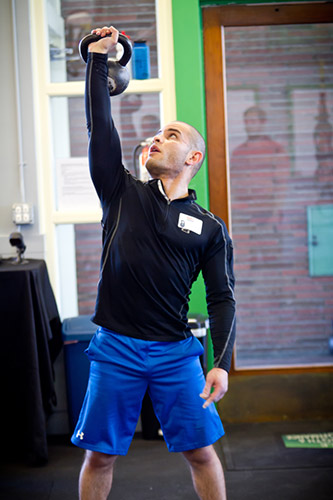
When I worked with
kettlebells at the RKC, I noticed that everything I didn't like about weightlifting didn't apply to the kettlebell. From the kettlebell swings to the deadlift, I felt like we were using full-body movements—and when using the kettlebell correctly, it really felt like an extension of the body especially on swings. Just trying to muscle the kettlebell around or only using my arms to pick it up definitely resulted in consequences. Until I got the technique, I was incredibly sore the next day in areas where I shouldn’t have been.
Kettlebell training has everything I look for in exercises to benefit my MMA. It helps my explosiveness, my ability to control my body, strengthens my core—all the things I really value are directly benefitted by correct kettlebell training.
Dragon Door: What do you feel is the greatest challenge MMA fighters can work on in the gym?
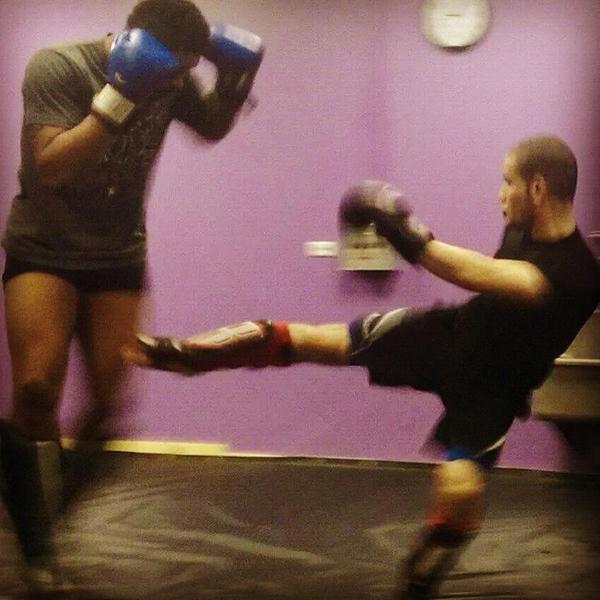 Ramy Daoud:
Ramy Daoud: The toughest thing for every MMA fighter is conditioning. The adrenaline dump in an MMA fight is different than in any other sport, even an intense basketball game. It’s on a totally different level, so conditioning and fitness need to be at an extremely high level.
Not only do you need the necessary fitness and conditioning to perform the techniques and fight against a resistant opponent, you also need to deal with the nerves—the adrenaline dump, and the crowd—which together can really tire you out. Conditioning needs to be at a supreme level just to do well at MMA. I'd say across the board, every MMA fighter—whether they want to admit it or not—struggles with the physical conditioning aspect of the sport.
Unfortunately, training for conditioning in MMA is not like older more established sports where the strength and conditioning coaches fully understand what the athlete needs and already know what specific training, and recovery are necessary. In MMA, it’s still a work in progress because MMA basically started in 1993. Athletes and coaches are still figuring out the best way to prepare people to step into the cage or ring and fight all out.
That’s why I like kettlebells—in a short amount of time, you can get a very intense workout. As a pro fighter, I don’t have extra time, but I do have time to add kettlebell work every day without sacrificing any of the other things I need to be doing.
Dragon Door: What's your favorite kettlebell exercise?
Ramy Daoud: The kettlebell deadlift, because it was super easy to learn and I wasn't bad at it! I had never deadlifted with a barbell, and it was good to learn with the kettlebell because it gave me a good foundation for the other exercises. It also helped me really understand the how to position my body and use my legs, not my back. These things are probably very obvious and simple, but it was all pretty new to me, so I was really excited.
Dragon Door: What do you think is the best kettlebell exercise for MMA?
Ramy Daoud: Easily the kettlebell swing, those are awesome for MMA. Especially because you’re really having to use your legs and hips—in MMA the explosiveness and power come from the whole body, but mainly the lower body. Swings are awesome for any MMA fighter.
Dragon Door: And you have a fight coming up soon?
Ramy Daoud: My fourth professional fight in July. Right now I am 3 and 0 so far as a pro, and I want to keep that going. Then I have another fight in August for the XFO. I have a busy schedule with competition and running a martial arts gym with a good friend in Lisle, Illinois. I'm always busy training and then getting ready for my own fights.
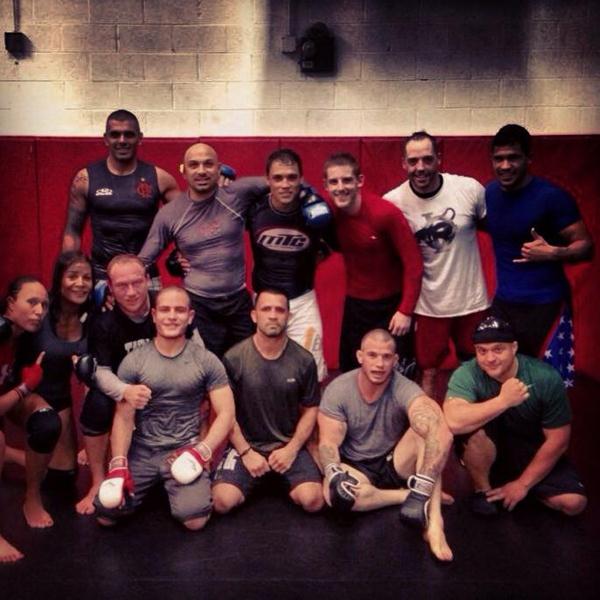
Dragon Door: How long have you owned the martial arts gym with your friend?
Ramy Daoud: We started it in May last year, and it’s exciting because we’re both young guys in our 20s and hadn’t imagined having a gym at this age. It’s unusual to open a school and start coaching before you’re finished competing, and both of us are competing. But in our area, there was a real need for a legitimate MMA gym teaching valid technique.
MMA is functional like kettlebell training—there's many of parallels between the two. There's no bs in kettlebell training, you have to know what you're doing—the same is true for MMA. Sometimes in other martial arts, instructors can hide behind mysticism and secret techniques, but in MMA it’s all functional.
One of the coolest things we do at the gym is coach a youth karate competition team. They don't come to us for karate, we train them for speed, agility, athleticism. They just went to Vegas and competed in the Junior International Cup. One of my 9 year old students won 1st place in his division and another took third place in his division. I still can't wrap my head around the fact that one of my students is at that high a level of his sport that young. I try not to let it get to my head, but feel like it helps to validate us as a school and as coaches. I am really proud of the karate team—they work so hard.
Dragon Door: Will you be teaching kettlebell classes at your gym?
Ramy Daoud: I can't wait to pass everything I’ve learned to my students—they're really going to benefit. I definitely want to add the RKC style training to my gym, and we just received a shipment of Dragon Door kettlebells. Dragon Door and John Du Cane have been very generous with their sponsorship, and we're happy to be a part of this whole organization.
Dragon Door: Do you have a favorite kettlebell workout or combination?
Ramy Daoud: My favorite thing with kettlebells so far—and I am still a humble beginner—is combining kettlebell exercises that target different body parts like kettlebell squats then cleans or swings. I really like changing it up mid-workout because that random broken rhythm is similar to MMA because there’s not a pace in MMA—you don't know what your opponent is going to do! If your opponent rushes you, you need to be able to react, it's very fatiguing.
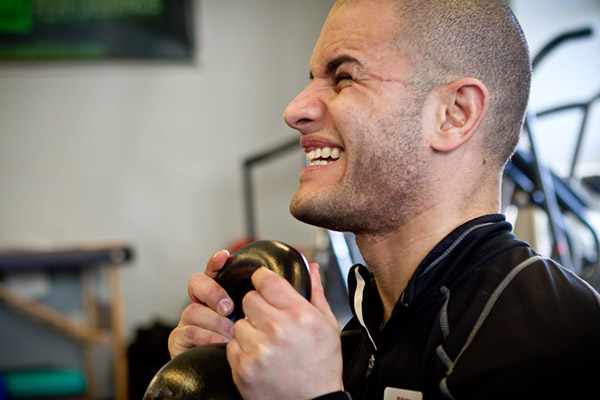
In MMA there is no pace or rhythm, and I like to simulate that in my kettlebell workouts. They're great because it's hard to develop an "easy" pace with kettlebells—they're constantly challenging especially when you switch from exercise to exercise.
Dragon Door: That kind of comes back to what you said earlier about the adrenaline dump in competition, can kettlebell training help you with that as well?
Ramy Daoud: Anyone who has competed or who has been nervous about something has probably experienced some form of adrenaline dump. Even though I’ve done many different things in my life, nothing compares to the adrenaline dump I feel when I compete in MMA. It’s just me and another person locked in a cage and you win when your opponent quits, they can't fight anymore, or you fight the whole match and the judges pick the winner.
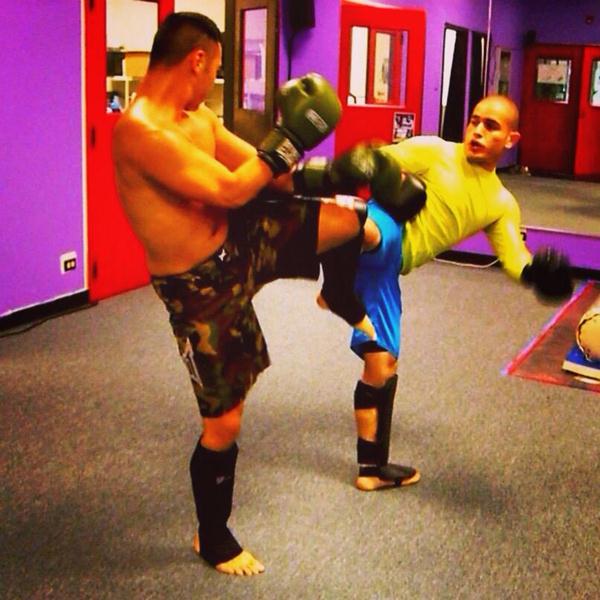
It's a pretty brutal and primal sport—and that will make you nervous! It can inspire fear and nervousness—everyone feels it. It’s hard to mentally and physically train for that experience. It’s why MMA fighters are known for their conditioning, and why they try to find training methods that will push them to their absolute limits. We have to learn to work hard enough to get to the point where fatigue then push through that fatigue.
Kettlebells are not only very tiring, they’re challenging because you have to stay focused. I can’t get lazy and perform a technique improperly—not only will that be less effective, it can be dangerous too! You can’t just shut off like many people do when running on a treadmill. With a kettlebell it's technical, you have to stay sharp you have to stay vigilant and do the techniques correctly.
In MMA, when I'm fighting, I can't perform a sloppy submission because I'm tired, I have to do it right no matter what my body is going though. That's why it's similar, because you have to stay technical and mentally sharp during fatigue and adversity.
Dragon Door: What was difficult for you at the Seattle RKC?
Ramy Daoud: The snatches! I passed all the
tests except for the snatch test, so I will be sending in a video of that soon. I failed it because I was just using my arms! You have to do the snatches correctly—100 snatches in 5 minutes with a weight that's specific to your weight class—to pass. Unfortunately, with my limited weightlifting experience, I had to pretty much learn how to snatch on the same day as we tested.
I kept thinking that I was strong and athletic enough to just muscle through the test—it sounds stupid to say that now, but it’s what was going on in my head! So I started the test, and was just not doing it correctly, wasn’t bringing the kettlebell back through my legs enough and was only using my arms to bring it back up. I ran out of time and wondered how anyone could do 100 of these!
The next day I was sore in all these areas I should not have been. It was super challenging and humbling because I can usually just learn things right away, and even if I don’t know the technique 100% I can usually figure out a way around it. The snatch test showed me that I had to focus and learn the technique correctly or I wouldn't be able to perform or pass. I love the fact that I have to study and practice the technique. It really reminds me of the martial arts, it really is the same thing to be honest.
Dragon Door: What was the biggest thing you learned at the RKC Workshop?
Ramy Daoud: I learned a lot more than just specific kettlebell techniques.
Max Shank was awesome because he really explained how to design a workout, not only for yourself, but for clients and students too. We learned the optimum way to train, and gave some specific examples for MMA since I was there with two of my teammates. He really helped everyone a lot. There was a lot of personal attention and he also showed us specific things we could improve—not just with the kettlebell, but with training in general.
We learned how to plan a program and make the most of recovery, as well as how not to overtrain. MMA fighters constantly overtrain because we're taught, "More is better, no pain no gain, push through no matter what." But Max showed us how to be scientific with our approach, and that overdoing it too often can be counterproductive. My teammates and I learned a LOT about fitness in general.
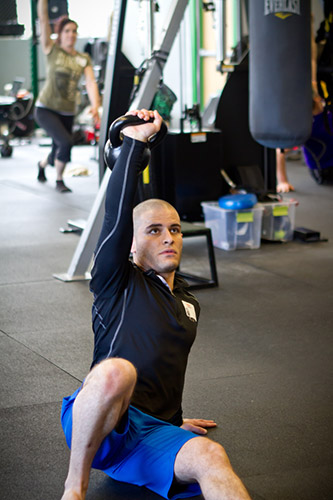
Dragon Door: What distinguishes you as an instructor and athlete?
Ramy Daoud: I come from a very well educated family—my sister graduated from the Northwestern School of Journalism. My parents are immigrants, my dad is Palestinian and had to leave his country, my Mom is Lebanese and grew up during the Lebanese Civil War. They both graduated from college and stressed education and finding a safe path in life—because of the circumstances they experienced.
So it was kind of crazy when in my final years of school, I decided to pursue something that didn't make much sense to most people. But, I don't ever see myself working a regular job. My family thought I was crazy, but I have made it work—I opened a martial arts school, I am an undefeated professional fighter, and have done many things people said I couldn’t do.
I am not superhuman, but I am not afraid to go after my dreams full force. Now, because of that I feel like I’m the hero of my family. Most of them are back overseas—it's only me, my parents, and my sister who are here in the US—and they all stay up overnight for my mom to call with news of my fights. It makes me really proud, and it sounds cocky, but it's the truth.
I am not afraid to fully go after my dreams, and have never doubted myself for a second. I think that’s why I've been successful so far and translates into how I am as a fighter and instructor too.
I like to share that idea with my students—whatever you want to do, go for it! Do not let anyone convince you to take "the safe route" just because they are intimidated by your ambition. My MMA career is more of a movement than just one person getting into the cage to compete.
If I’m not happy with how a practice goes, or if I am having a hard day—remember that I was once a young, asthmatic, un-athletic kid with low self esteem and now I am an undefeated professional athlete. And it is all due to ambition and determination. I wasn't set up to be this way, I used to be an asthmatic kid who woke up in the middle of the night unable to breathe—sometimes my parents would even have to rush me to the hospital!
When I was 5 or 6 years old, no one would have thought, "That kid is going to be a professional athlete one day!" They were hoping I could just graduate school without getting my ass kicked every day of the week! No one would have predicted what I'm doing now. It was great to find out I was an athlete, even if not in the traditional sense—I'm short, and don't enjoy playing football or basketball. But as a kid, when I started with martial arts as a way to build my self-esteem and confidence, I discovered that I had real athletic attributes. I am fast and strong, even though my cardio was always an issue because of asthma.
Even now it's still an uphill battle for me to have great conditioning. But, extreme determination and almost delusional levels of self-confidence have allowed me to be where I am at today.
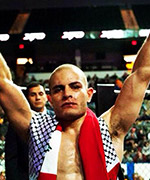 Ramy Daoud trains at Midwest Training Center mtcmma.com and is co-owner of Bang Boxing & Fitness BangBoxingandFitness.com. Find him on Facebook facebook.com/ramydaoudmma and follow him on Twitter: twitter.com/ramythegiant
Ramy Daoud trains at Midwest Training Center mtcmma.com and is co-owner of Bang Boxing & Fitness BangBoxingandFitness.com. Find him on Facebook facebook.com/ramydaoudmma and follow him on Twitter: twitter.com/ramythegiant
Back